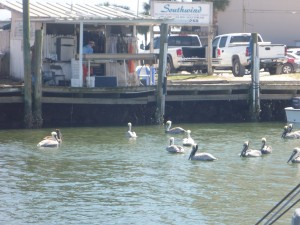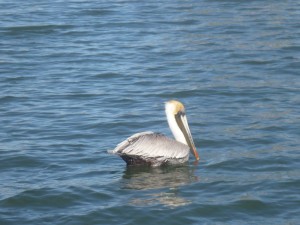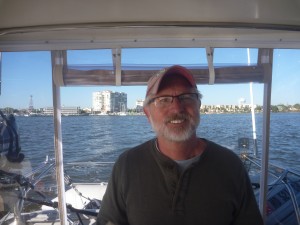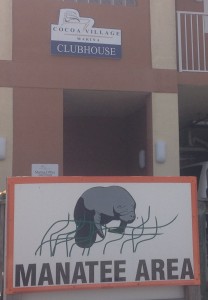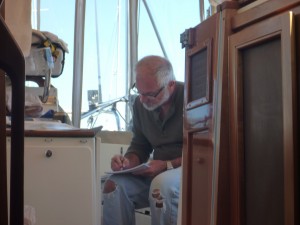7 April 2016 – We accomplished the goal of not doing even one mile of the ICW in Georgia on our transit north.
After spending a few days enjoying St. Simon’s Island, Georgia, we backtracked through the channel and headed back out to the ocean for our first overnight passage on this boat.
Timing was important for us as we planned for the passage to take about 19 hours (104 miles) and we wanted to arrive at the sea buoy of Port Royal Inlet (Beaufort, South Carolina) after sunrise so we could more easily navigate the channel. Calculating the time backwards, estimating our speed would be about 5 knots, we left St. Simon’s Marina around 1530 planning to arrive Port Royal Inlet around 0700 the next day.
St. Simon’s inlet is a long channel and we patiently motored along for 2 hours waiting to clear the shallow water on either side of us before turning north and putting up the sails.
The wind was favorably coming from the SW and we were looking forward to a lovely evening under sail under the stars.
We began hoisting the main sail and for some reason it was harder than usual for Christina to raise it even with the assistance of the winch. As she tugged and tugged, we finally recognized that something was wrong, and noticed that the halyard somehow got wrapped around forward of the mast. Oops! We didn’t know how that happened. So, we decided to lower the sail and untangle the mess and then start again.
We released the clutch to let the sail drop (usually the weight of the sail will just bring it down), but the sail didn’t budge. Uh oh! So the sail wouldn’t go up or down – this may be a problem.
Bob moved forward to assess the situation and realized that the halyard was securely wrapped around the steaming light on the front of the mast. Triple problem.
The sail was about 30% up, but with no shape and just laying against the shrouds. We couldn’t raise it. We couldn’t lower it. We couldn’t loosen the halyard to swing it around to untangle it from the offending light. What to do?
Bob tried to loosen the sail by pushing the sail cars that run along the mast up with the boat hook. Nope no joy.
Thinking that we may not be able to bring the sail down, the reality could be that someone would have to go up the mast to sort the mess out once we reached Beaufort.
Neither of us looked forward to “sailing” with the rag of a sail flopping around – it could be a bit embarrassing to pass other boats in this condition AND more importantly, would make docking at the other end a bit of challenge.
Bob made a phone call to a friend to pick his brain and see if he had any creative ideas. Eventually, after brainstorming a bit, Bob came up with the idea of attaching a spare halyard around the cars and then raising the halyard which would effectively raise the sail from below which eventually loosened the main halyard as there was less stress on it now.
Once the halyard was loosened, Bob was able to pull the sail down manually and then flick the halyard from around the steaming light and voila we were back in business.
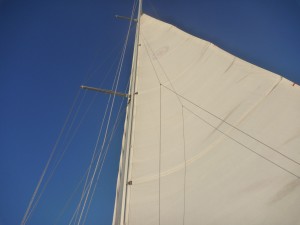 Take 2 – we raised the sail and prepared for the evening passage by setting the 2nd reef as we expected the wind to pickup overnight. (Reefs are used to decrease the size of the sail for big winds by only bringing it partially up the mast.)
Take 2 – we raised the sail and prepared for the evening passage by setting the 2nd reef as we expected the wind to pickup overnight. (Reefs are used to decrease the size of the sail for big winds by only bringing it partially up the mast.)
We cut the engine, rolled out the genoa and for the first time we really got to experience sailing this boat in the ocean the way it was intended – and we loved it.
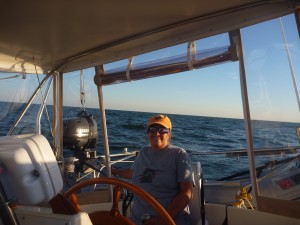 One of the most common questions we get from people when they hear that we live on a sailboat is whether we ever get seasick. While Bob has a strong stomach, Christina unfortunately does sometimes get a bit queasy and today after all that bobbing around in the water as we struggled with the sail, looking up the mast, down around, yanking and cranking on lines, and the bit of stress, the body eventually gave in and she suffered that uncomfortable queasiness. At first signs she donned the funny looking glasses with liquid in the frames to help the brain maintain equilibrium, which we had heard helped alot of other people. They seemed to work at first but not entirely and for the next couple of hours she nibbled on crackers, sipped on ginger ale and napped while Bob took the first watch. Seasickness is unfortunately a part of the experience which she hopes occurs less frequently.
One of the most common questions we get from people when they hear that we live on a sailboat is whether we ever get seasick. While Bob has a strong stomach, Christina unfortunately does sometimes get a bit queasy and today after all that bobbing around in the water as we struggled with the sail, looking up the mast, down around, yanking and cranking on lines, and the bit of stress, the body eventually gave in and she suffered that uncomfortable queasiness. At first signs she donned the funny looking glasses with liquid in the frames to help the brain maintain equilibrium, which we had heard helped alot of other people. They seemed to work at first but not entirely and for the next couple of hours she nibbled on crackers, sipped on ginger ale and napped while Bob took the first watch. Seasickness is unfortunately a part of the experience which she hopes occurs less frequently.

It was a clear moonless night under the stars and quite lovely if not a bit chilly. The wind died down after a couple of hours and we ended up starting the engine and motor sailing the rest of the night.
We kept the boat on auto pilot most of the time and took turns alternating between taking naps and being on watch throughout the night.
Being on watch entails looking out into the dark to see any lights that could be boats heading toward us. We also have fabulous electronics including AIS and radar. With AIS we are able to identify any vessels in the vicinity that transmit AIS (most large ships, commercial vessels and many cruising boats transmit). The AIS tells us the vessel’s name, the course they are on, their speed, how close we will cross paths if both vessels stay on course, and how long before we get to that point.
We watched a light to our stern get closer and closer, and identified it as the American Star, a cruise ship, that according to AIS would pass within half a mile of us. That is a bit closer than we would like. Christina hailed them on the radio to be sure they knew we were there. Without electronics all they would be seeing would be a small white light on our mast to know we were there, assuming they were actually looking out.
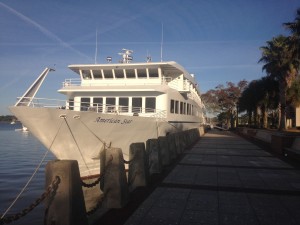 The captain was very gracious and professional. He acknowledged he did see us on his AIS and asked if we had a preference as to which side he passed us on, starboard or port. We told him we had no preference, just as long as he didn’t run us over. He agreed, and decided to pass us on our starboard side. It was still another half hour before he actually did pass us within a mile or less without incident. It was indeed comforting to know that he had us on AIS and the verbal conversation may not have been necessary but reassuring that he knew to be on the lookout for us, otherwise watching him get so close would have been pretty stressful. (We would see her again in daylight as she stopped in Beaufort the next day, when this photo was taken.)
The captain was very gracious and professional. He acknowledged he did see us on his AIS and asked if we had a preference as to which side he passed us on, starboard or port. We told him we had no preference, just as long as he didn’t run us over. He agreed, and decided to pass us on our starboard side. It was still another half hour before he actually did pass us within a mile or less without incident. It was indeed comforting to know that he had us on AIS and the verbal conversation may not have been necessary but reassuring that he knew to be on the lookout for us, otherwise watching him get so close would have been pretty stressful. (We would see her again in daylight as she stopped in Beaufort the next day, when this photo was taken.)
In addition to AIS we also have radar. With radar we are able to “see” large objects in the area. Some of these may be vessels, some of these may be buoys and some of these may be debris. But at least we know there may be something out there, and if we see something on radar we can consult the charts to identify the object, or AIS to identify the vessel, and if not able to identify then we know to stay alert.
Although we know not to be totally dependent on electronics because they do fail at times, and not all vessels have AIS, and other hazards are not always evident on radar – we have come to the conclusion that good electronics was money well spent for our peace of mind.
So standing watch entails not only peering out into the dark abyss, but also checking the compass to be sure we are still on course, reviewing AIS and radar regularly to see if something is approaching or nearby and most importantly staying awake!
We were making better time than expected and realized we would be approaching the inlet long before sunrise, so we cut back the engine to slow our pace. But even with that, when we arrived before the sun began peeking over the horizon, we motored further out in the ocean to lower the sails and kill some more time.
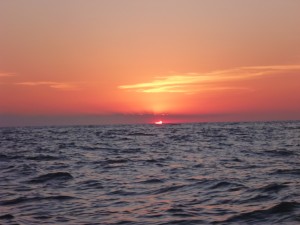 With the sails down, and the sun edging up, we entered Port Royal Inlet, enjoying our first sunrise on the water, and began making our way toward Beaufort, South Carolina. Over three hours later we were tied up at the marina, a bit tired but happy our first overnight passage went as well as it did.
With the sails down, and the sun edging up, we entered Port Royal Inlet, enjoying our first sunrise on the water, and began making our way toward Beaufort, South Carolina. Over three hours later we were tied up at the marina, a bit tired but happy our first overnight passage went as well as it did.
We planned to stay in Downtown Marina in Beaufort for 2 nights at least, and then make a decision as to whether we go back out to the ocean or begin making our way back up the ICW toward Charleston, South Carolina.
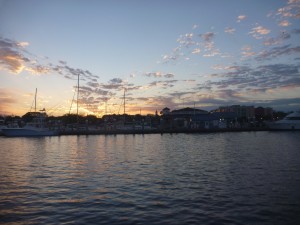
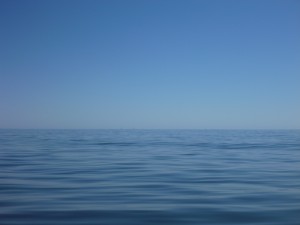
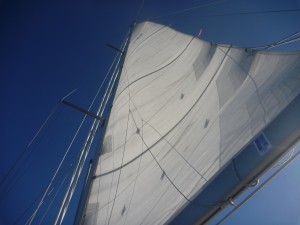
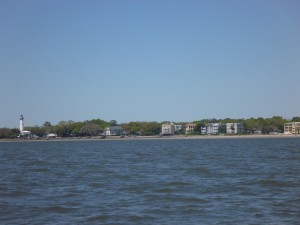
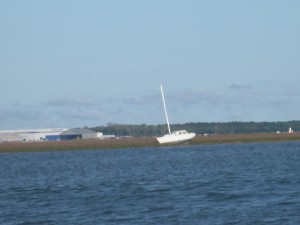
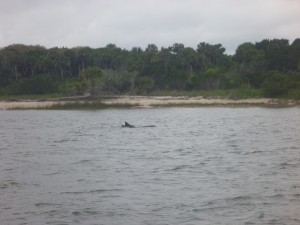
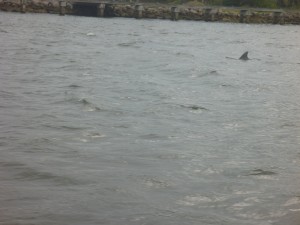 Daily dolphin sightings are the norm and today we were able to capture photos of a few dorsal fins to prove it.
Daily dolphin sightings are the norm and today we were able to capture photos of a few dorsal fins to prove it.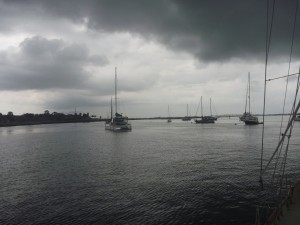
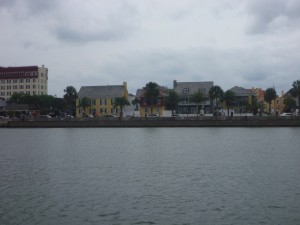
 St. Augustine – we will see you again and explore your treasures another time – just not on this trip.
St. Augustine – we will see you again and explore your treasures another time – just not on this trip.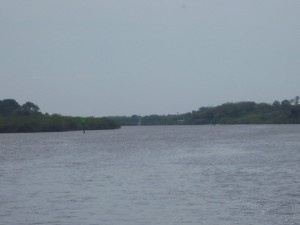
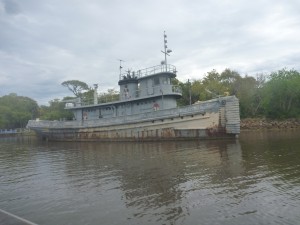 One of the more interesting sights along the way.
One of the more interesting sights along the way.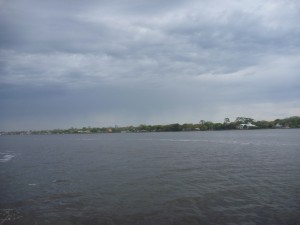 Once we were tied up in Palm Coast Marina we quickly made our way to
Once we were tied up in Palm Coast Marina we quickly made our way to 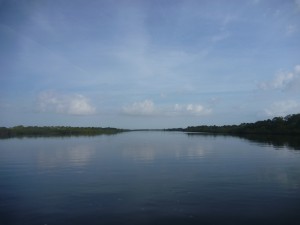
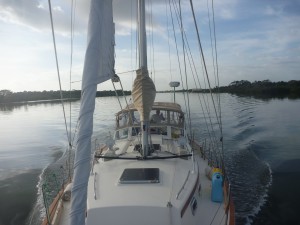 Christina took advantage of the calm water and headed to the end of the bowsprit to get another photo of the boat from this angle.
Christina took advantage of the calm water and headed to the end of the bowsprit to get another photo of the boat from this angle.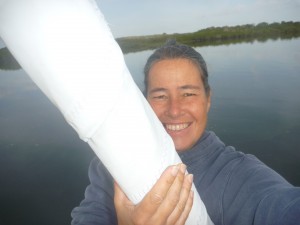
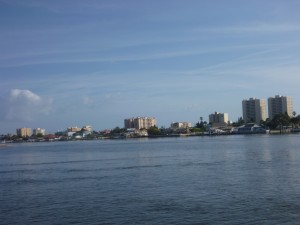
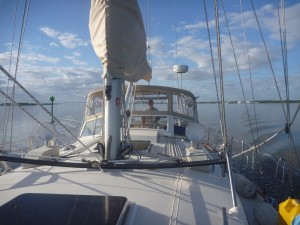
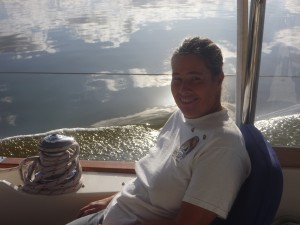
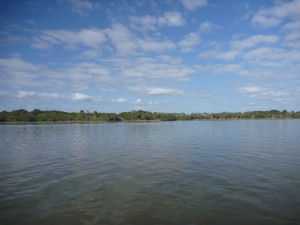
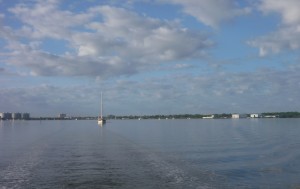
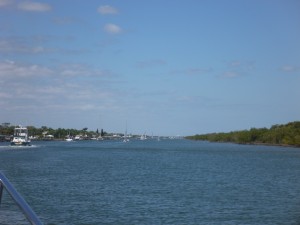
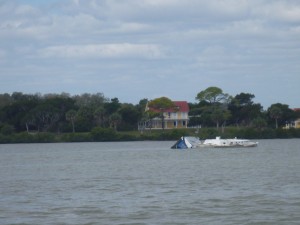 Unlike our transit south a few months ago where we would usually only see a few boats per day , today there was a steady stream of boats going north and we felt like we were in a parade of boats throughout the day.
Unlike our transit south a few months ago where we would usually only see a few boats per day , today there was a steady stream of boats going north and we felt like we were in a parade of boats throughout the day.